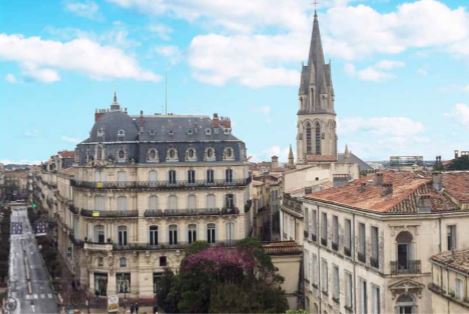IT HARDLY ever rains in Montpellier,” apologised tour guide Celine Dupin, as our shiny, black umbrellas sheltered us from a downpour. While the persistent rain threatened to discredit Ms Dupin, the personable guide distracted us with intriguing insights into the sprawling city, a mere ten kilometres from the Mediterranean Sea.
Montpellier is the capital of the LanguedocRoussillon region and the eighth largest city in France. An enormous city square welcomed us, as colourful trams trundled by and a brightly painted carousel took youngsters for a ride. The expansive visitor’s centre was heaving with tourists, eagerly collecting ideas for their stay.
The walking tour was fascinating. We peered into the waters of a 13th century Mikveh (Jewish ritual bath) discovered by an inquisitive archaeologist centuries after a multi-storey residence had hidden it. We watched a resident drape his wet laundry over a stone balcony overlooking the inner courtyard of a so-called private mansion, learning of the city’s rich history and the everyday life of a local. Nearby, the bustling central market offered a standard collection of wares: from tacky souvenir caps to saucy lingerie and silly key rings, through to chunky socks, stylish shoes and practical belts.
Jutting from the city square, modern shopping centre La Galeries Lafayette (multi-level department store) and dozens of chain stores were satisfactory but it was the beguiling boutiques peppering the cobblestone streets that really impressed. Delicate handicrafts, designer jewellery and pretty scarves took our fancy.
A visit to the art gallery, Musée Fabre de Montpellier Mediterranee Metropole, just metres from the city square, left the group spellbound. The eclectic collection of old and new was a credit to the curators. There were many more galleries but a shortage of time to investigate.
Stepping out of Montpellier, we didn’t have to look far for towns steeped in history and natural beauty. In Castries, a fifteen minute drive from Montpellier, we toured the stunning fields of a bull ranch (Manade Vitou) in a horse-drawn open carriage. A group of men, and a five year old boy, showcased the traditional “rounding up of the bulls”, watching us tremble as the largest, most intimidating beast (named Stefan) stopped a few metres short of us – just to glare at the group. Meanwhile, and thankfully, the long-standing myth that the colour red angers bulls was dispelled, as I wore in my new blood-red jumper.
The town of uzés, about an hour from Montpellier, was postcard perfect – a combination of cobblestones, cafes and classic buildings. We even chanced upon a local woman draped in medieval garb on her way to “carnival.”
Clambering across the top of the Pont du Gard – a stunning example of a Roman aqueduct built around 50 AD and a classified uNESCO World Heritage Site that crosses the Gardon River – we were gobsmacked with the spectacular view, while savouring the serenity of the riverside forest.
Accommodation was at nearby La Bégude Saint Pierre in Vers Pont du Gard – a stonewalled, seventeenth century former coach house, with its 23 rooms and suites boasting original, exposed wooden beams, modern bathrooms and large balconies – surrounded by 14 hectares of pristine countryside. It was easy to while away the evening on a terrace overlooking century-old olive trees and a good-sized swimming pool.
Two hours from Montpellier appeared the beachside town of Collioure with its Catalaninfluenced architecture, cuisine and style. The imposing Chateau Royal cast a shadow over the handful of bathers frolicking in the aqua sea. The lighthouse and pebble beach perfected the view, as a leisurely stroll was enjoyed under blue skies.
The city of Pézenas, untouched by the industrial revolution and a 45 minute drive from Montpellier, was home to playwright Moliere for more than a decade in the 1600s. We meandered past the barber shop the “ writer had frequented, wondering if he’d picked up gossip for his comedic writings as he sat for a trim. A short walk from the centre we found La Distillerie de Pézenas, where an incredible meal was served (including a wonderous Confit rib of Pata Negra pork and olive crumble), excellent wine poured and magnificent spa and lodgings admired.
Our amazing guide, Ms Dupin, had proudly showcased her adopted city and surrounds, still insisting that for at least 300 days of the year, visitors are greeted by sunshine – not pesky dark clouds and rain. By the end of the trip, we were very nearly convinced.



